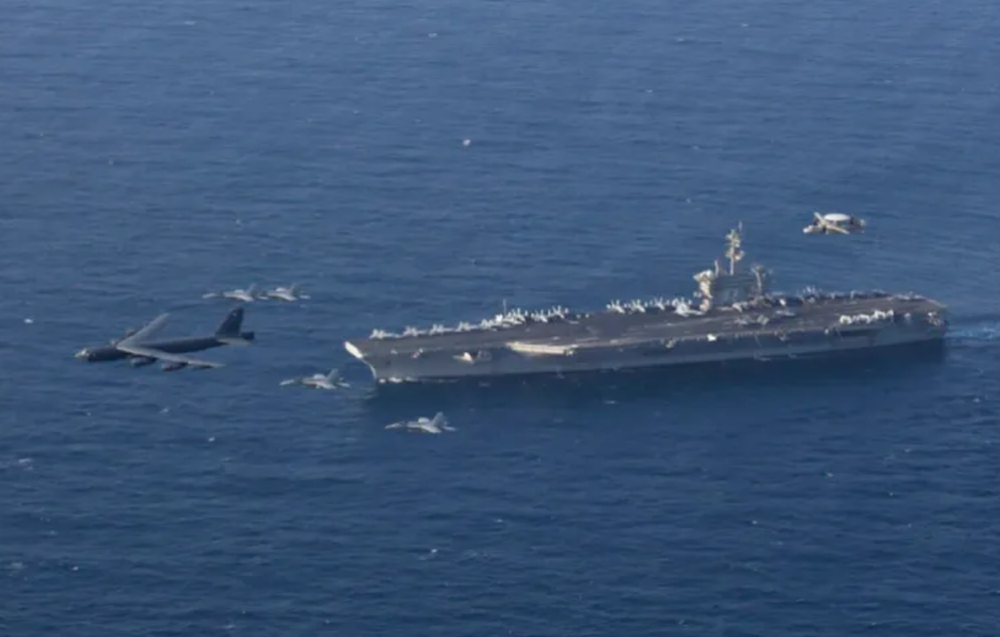YAF drones, missiles 'freak' US Navy over attacks on destroyers
The Yemeni Armed Forces drones and missiles continue to expose the vulnerabilities in the Navy’s surface fleet.
-

The USS Abraham Lincoln carrier and US Air Force the B-52H Stratofortress conduct joint exercises in the Arabian Sea in 2019. (AP)
According to Brandon J. Weichert, a recent attack from the Yemeni Armed Forces (YAF) on US Navy destroyers underscored the vulnerabilities of the Navy's surface fleet.
In response to the ongoing US and British aggression against Yemen and in support of the Palestinian and Lebanese people, the Yemeni Armed Forces (YAF) announced Tuesday two major military operations targeting US naval assets in the region, inflicting significant damage on American ships.
The first operation targeted the US aircraft carrier USS Abraham Lincoln in the Arabian Sea. Using a combination of cruise missiles and drones, Yemeni forces struck the vessel while it was reportedly preparing for operations against Yemen. The statement said the operation thwarted an impending American aerial assault, achieving its objectives without interruption.
The second operation targeted two US destroyers in the Red Sea with ballistic missiles and drones, again claiming successful strikes against the vessels.
Weichert writes in National Interest Undersecretary of Defense for Acquisition and Sustainment Bill LaPlante stated that what the YAF had accomplished with their missile and drone operations in the previous year was unparalleled.
He notes that Harrison Kass revealed that the USS Dwight D. Eisenhower had a close call during its encounter with the YAF, coming dangerously close with a missile - only 200 meters.
Weichart recalls how shortly after, the Americans withdrew their visibly vulnerable aircraft carriers, fearing the destruction of these expensive and exposed ships. Instead, they turned to smaller surface warships like the mentioned destroyers.
The US Navy's surface fleet comes up against considerable hurdles from the relatively less sophisticated YAF, demonstrating gaps in dealing with anti-ship ballistic missiles—weaknesses that may be vital in a possible fight with China.
However, the broader issue, Weichart notes, is that the YAF demonstrated how to hinder US Navy force projection. America's more advanced adversaries, particularly China, are taking extensive notes and planning to use these methods on a bigger scale against the US Navy if a conflict between China and the United States breaks out.
US, UK were preparing for aggression
A high-ranking source speaking exclusively to Al Mayadeen confirmed that US and British military formations, including swarms and combat units, were launched toward Yemen on Monday but were successfully repelled by the Yemeni Army. The source noted that the advancing forces were forced to retreat following a decisive response from the Yemeni military.
The source further revealed to Al Mayadeen that the US and British forces had been preparing for a large-scale offensive against Yemen, but the operation was thwarted by a precise and strategic military action carried out by the Yemeni Army. The source emphasized that the operation, which was described as "highly accurate", had effectively disrupted the enemy's plans.
According to the source, the military operation was not only a defensive maneuver but also an intelligence-driven, highly targeted strike. The Yemeni forces, the source explained, had meticulously analyzed the battlefield, allowing them to anticipate the movements of the enemy and preemptively strike with precision.
The source stressed that the Yemeni Army's approach to operations is deeply rooted in thorough intelligence gathering and careful analysis of the operational theater. This enables the Yemeni forces to stay one step ahead of their adversaries, ensuring they remain prepared for any future threats.
Aggression on Yemen endures
Yemeni media outlets reported on Tuesday, before sunrise, that the American-British aggression warplanes launched three airstrikes on the al-Fazah area in the al-Tuhayta district, south of the Hodeidah governorate.
On Monday, the American-British coalition also launched an aggression on Yemen, launching a total of nine airstrikes on the Saada and Amran provinces.

 4 Min Read
4 Min Read








